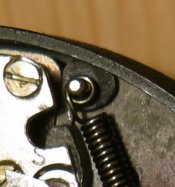Even a bit of oil or debris will compromise the swiftness of this extremely fast speed (for this type of shutter). And, being under tension for years and years does not help. (Indeed, I wonder how much slower it would be if cold?)
Theoretically, I would flush it out with lighter fluid (after removing all lens elements) and then let it dry thoroughly. That might help greatly, but there is always the problem of getting lighter fluid into the helicoid and transferring that gunk onto those shutter blades. Thus, maybe that 'advice' should rest within the realm of theory if you do not know what you are doing. However, if you can remove the shutter from the helicoid and clean the threads COMPLETELY, you are free then to flush the mechanism thoroughly with lighter fluid. That is what I would do. Actually, the spring looks pretty robust to me and does not seem to have suffered from 'years of being under tension'.
If not, perhaps, in your immediate case, the best thing to do is to deal with it as it is. 1/100 is not too slow and will stop at least some action. But, beware, if cold: does it fire as rapidly? Make tests. - David Lyga



 )
)